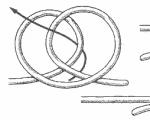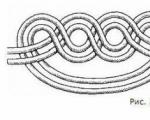Baby knot. That's exactly what sailors shouldn't do - tie this knot. A naval man who unluckily tied a woman's knot even on the shore will surely be ridiculed by his colleagues. Knots for tying two cables - flagship children's sailing school
Babi knot
Let us make a reservation in advance that the author deliberately placed this knot in the book, as an example to explain the principle of other marine knots.
A woman's knot... How much irony and disdain can be heard on the part of sailors towards this primitive and, unfortunately, firmly rooted knot in our life! What sailors shouldn't do is tie a woman's knot. The naval man, who unluckily tied this knot even on the shore, will surely be ridiculed by his colleagues: they say, a shame for the fleet! But, alas, among land people this knot is a station wagon. The vast majority of people who are not familiar with rigging, or those who, by their profession, do not deal with ropes, ropes, or threads, use a woman’s knot in all cases when they need to tie, tie or tie something . It seems that people, having mastered this knot in childhood, believed in its utility so much that they don’t even want to hear about any other complex sea knots. Nevertheless, speaking seriously, this traitor knot has done a lot of trouble in the entire history of mankind and even claimed a lot of human lives.
The Babi knot consists of two half-knots tied in series one above the other in the same direction. If he ties two ropes and pulls, then it is immediately clear that he begins to move along the rope, to slide along it. And if you tie it close to one of the connected ends of the rope, then when pulling it, it can slip and will certainly slip if the connected ropes are of different thicknesses. Unfortunately, not everyone knows about this and continues to use it.
In our country, this knot got its name due to the fact that from time immemorial women tied the ends of headscarves with it (it is very convenient for this purpose). Abroad, it is called "grandmother's", "stupid", "veal", "false", "light green" knot.
But, oddly enough, the woman's knot is used in their work by sailors and fishermen of some countries. In addition to its negative qualities (to slip and not succumb to untying), they caught one of its positive properties - under certain conditions, instantly turn into a simple bayonet (see Simple bayonet) - into one of the simplest and most reliable marine knots for securing a mooring vessel on the shore for fell, bollard or mooring bollard. But in order to tie a simple bayonet when mooring, you need to get off the ship ashore and do it directly at the fell or put the end on the shore so that those on the shore do it. But it turns out that a simple bayonet can be tied to a bollard without leaving the ship ashore. And this is done with the help of a woman's knot despised by sailors ... To do this, at the end of the cable, which they intend to bring ashore for fastening it with a simple bayonet around the fell, a loop is made, the running end of the cable is connected to the root end of the woman's knot, which is not fully tightened. From the side of the ship, this loop is thrown onto the fell. When jerking at the root of the mooring line, the woman's knot turns into a simple bayonet.
The author of this book has more than once seen how small motor boats and fishing boats are moored in this way in the ports of the Persian Gulf, Japan and the Karamandel coast of India.
Sea knots. - M.: Transport. L. M. Skryagin. 1984
See what the "Baby Knot" is in other dictionaries:
Babiy: Oleksandr Nikolayevich Babiy (Ukrainian: Oleksandr Mykolayovich Babiy; July 9, 1968, Tashkent, USSR) is a former Ukrainian football player and defender. Boris Musiyevich Babiy (1914 1993) Ukrainian Soviet scientist historian. Babiy, Vasily Vasilyevich ... ... Wikipedia
This term has other meanings, see Node (meanings). See also: List of knots Knots: 1. Mold 2. Manrope knot 3. Babi knot (unreliable, deadly)! 4. Rosebud stopper knot (?) ... ... Wikipedia
See also: List of knots Knots: 1. Splice 2. Manrope knot 3. Babi knot (unreliable, deadly)! 4. Rosebud stopper knot(?) 5. Matthew Walker knot 6. Shroud knot 7. Turks head knot 8. Simple figure eight knot. 9. Straight knot. 10. Double ... ... Wikipedia
- (Knot) 1. Any fight or loop made on the tackle or around anything; tying the ends of the ropes together. U. babii (Grannies knot, carrick bend) incorrectly tied straight or reef U. U. gazebo (Bowline hitch) reliable, ... ... Marine Dictionary
How much irony and disdain can be heard from the side of the sailors to this knot that has firmly taken root in our life! Among land people, this knot is a universal. The vast majority of people use the woman's knot in all cases when they need to tie, tie or tie something. And this traitor knot in the entire history of mankind has done a lot of trouble and even claimed a lot of human lives.
Babi knot It consists of two half-knots tied sequentially one above the other in the same direction. If he ties two ropes and pulls, it is immediately clear that he begins to slide along the rope. And if you tie it close to one of the tied ends of the rope, then when pulling it, it will surely slip off, especially if the tied ropes are of different thicknesses. Unfortunately, not everyone knows about this and continues to use it.
In our country, this knot got its name from the fact that from time immemorial women tied the ends of headscarves with it (it is very convenient for this purpose). Abroad, it is called "grandmother's", "stupid", "veal", "false", "salag". 
But the woman's knot also has one positive property - under certain conditions it instantly turns into a simple bayonet - one of the simplest and most reliable knots for securing a mooring vessel to a bollard, bollard or mooring bollard. To do this, a loop is made at the end of the cable, which they intend to bring ashore, the running end of which is connected to the indigenous woman's knot, which is not fully tightened. This loop from the side of the ship is thrown onto the fell. When jerking for the root mooring line, the woman's knot turns into a simple bayonet. In this way, small motor boats and fishing boats are moored in the ports of the Persian Gulf and the Karamandel coast of India.
"Teschin" knot
Knot resembling a woman. But, if at the woman’s knot the ends come out of the knot on one side, then at the “mother-in-law’s” knot they come out from different sides diagonally. "Teschin" knot is as insidious as a woman's (if not more). It should never be used under any circumstances. Posted here to show how not to tie knots. 
straight knot
Archaeological excavations indicate that the Egyptians used this knot approximately three thousand years before our era. The ancient Greeks and Romans called it Nodus Hercules - the Hercules or Hercules knot, because the mythical hero Hercules tied the front paws of the skin of the lion he had killed on his chest with it. The Romans used the straight knot to stitch wounds and heal broken bones. He represents two semi-knots, sequentially tied one above the other in different directions.

The Ashley Knot Book (London, 1977) says the following about the direct knot: “Previously, this knot had a specific meaning in the fleet - they tied the reef seasons of the sails when they took the reefs. Previously, sailors had never used it to tie two ropes if the latter were of different thickness or dressing. It should not be used to connect two cables that would be subject to strong traction. Wet, he crawls ...
This knot, used to tie two cables, claimed more human lives than a dozen other knots combined. 
But it is reliable enough if its running ends are attached to the main ones or fixed by control nodes.
The ancient Romans called it the "women's knot" because it was with this knot that the Roman women tied the sashes of their tunics.
This is a good knot for packing things, bundles, etc.
(grandmother's, stupid, veal, false, green knot, traitor knot)
Primitive, simple knot. It is used for tying two ropes of the same diameter. This node is called a traitor node because in the entire history of mankind it has done many troubles and claimed many human lives. But, unfortunately, this knot has become very widespread in our country.
The Babi knot consists of two half-knots tied in series one above the other in the same direction.
In our country, the knot got its name due to the fact that from time immemorial women have tied the ends of headscarves with it (it is very convenient for this purpose).
Oddly enough, the woman's knot is used in their work by sailors and fishermen. In addition to negative qualities (it slips and can be untied), this knot has a positive property - under certain conditions it instantly turns into a simple bayonet - one of the simplest and most reliable knots. To do this, the running end of the rope carries out the support, then the woman's knot is knitted with the root end of the rope (without tightening it). After that, we make a strong jerk for the root of the rope, and the woman's knot turns into a simple bayonet.
When tying two ropes with a woman's knot, safety knots must be tied at the running ends of the ropes.
"Teschin" knot
Just as when knitting a straight knot, you can make a mistake and tie a thief's knot, so when knitting a woman's knot, you can tie a mother-in-law's knot.

This knot is even more dangerous than the thief's knot. In the classroom, it must be considered and paid attention to the differences from the woman's knot. If at the woman's knot the running ends come out of the knot on one side, then at the mother-in-law's knot they come out from different sides diagonally. Under no circumstances should the knot be used under any circumstances.
"Herbal" knot
When preparing tourists may not be studied.
It is used to tie two ropes of the same diameter. Despite its name, this elementary unit is quite reliable and can withstand heavy loads. In addition, it is easily untied in the absence of traction. The principle of knitting a knot is half-bayonets with other people's ends.

The knot is very convenient for tying slings (ribbons). When tightening the herbal knot by the root ends, the knot twists and takes on a different shape. When it is finally tightened, the two running ends look in the same direction. When using this knot, it is obligatory to knit two safety knots (one at each running end).
Babi knot
Babi knot... How much irony and disdain can be heard on the part of sailors towards this primitive and, unfortunately, firmly rooted knot in our life! What sailors shouldn't do is tie a woman's knot. The naval man, who unluckily tied this knot even on the shore, will surely be ridiculed by his colleagues: they say, a shame for the fleet! But, alas, among land people this knot is a station wagon. The vast majority of people who are not familiar with rigging, or those who, by their profession, do not deal with ropes, ropes, or threads, use a woman’s knot in all cases when they need to tie, tie or tie something . It seems that people, having mastered this knot in childhood, believed in its utility so much that they don’t even want to hear about any other complex marine knots. Nevertheless, speaking seriously, this traitor knot has done a lot of trouble in the entire history of mankind and even claimed a lot of human lives.
The Babi knot consists of two half-knots tied in series one above the other in the same direction. If he ties two ropes and pulls, then it is immediately clear that he begins to move along the rope, to slide along it. And if you tie it close to one of the connected ends of the rope, then when pulling it, it can slip and will certainly slip if the connected ropes are of different thicknesses. Unfortunately, not everyone knows about this and continues to use it.



Rice. 23. Babi knot: a - knitting scheme; b - the transformation of the woman's knot into a simple bayonet
This knot got its name due to the fact that from time immemorial women have tied the ends of headscarves with it (it is very convenient for this purpose). It is also called "grandmother's", "stupid", "veal", "false", "salaga" knot.
But, oddly enough, the woman's knot is used in their work by sailors and fishermen of some countries. In addition to its negative qualities (to slip and not succumb to untying), they caught one of its positive properties - under certain conditions, instantly turn into - one of the simplest and most reliable marine knots for securing a mooring vessel on the shore for a fell, bollard or berthing bollard. But in order to tie a simple bayonet when mooring, you need to get off the ship ashore and do it directly at the fell or put the end on the shore so that those on the shore do it. But it turns out that a simple bayonet can be tied to a bollard without leaving the ship ashore. And this is done with the help of a woman's knot despised by sailors ... To do this, at the end of the cable, which they intend to bring ashore for fastening it with a simple bayonet around the fell, a loop is made, the running end of the cable is connected to the root end of the woman's knot, which is not fully tightened. From the side of the ship, this loop is thrown onto the fell. When jerking at the root of the mooring line, the woman's knot turns into a simple bayonet.
How much irony and disdain can be heard on the part of sailors towards this primitive and, unfortunately, knot that has firmly taken root in our life. That's exactly what sailors shouldn't do - tie this knot. A naval man who unluckily tied a woman's knot even on the shore will surely be ridiculed by his colleagues. Like, this is a shame for the fleet. But, alas, among land people this knot is a station wagon. The vast majority of people who are not familiar with rigging, or those who, by their profession, do not deal with ropes, ropes, or threads, use a woman’s knot in all cases when they need to tie, tie or tie something . It seems that people, having mastered this knot in childhood, believed in its utility so much that they don’t even want to hear about any other complex marine knots. Nevertheless, speaking seriously, this traitor knot in the entire history of mankind has done a lot of trouble and even claimed a lot of human lives. The Babi knot consists of two half-knots tied in series one above the other in the same direction. If he ties two ropes and pulls, then it is immediately clear that he begins to move along the rope, to slide along it. And if you tie it close to one of the connected ends of the rope, then when pulling it, it can slip and will certainly slip if the connected ropes are of different thicknesses. Unfortunately, not everyone knows about this and continues to use it. In our country, this knot got its name due to the fact that from time immemorial, women tied the ends of headscarves with it. Abroad, it is called "grandmother's", "stupid", "veal", "false", "salaga" knot. But, oddly enough, the woman's knot is used in their work by sailors and fishermen of some countries. In addition to its negative qualities (to slip and not succumb to untying), they caught one of its positive properties - under certain conditions, instantly turn into a simple bayonet - into one of the simplest and most reliable marine knots for securing a mooring vessel on the shore for a fell, bollard or mooring bollard . But in order to tie a simple bayonet when mooring, you need to get off the ship ashore and do it directly at the fell or put the end on the shore so that those on the shore do it. But it turns out that a simple bayonet can be tied to a bollard without leaving the ship ashore. And this is done with the help of a woman’s knot despised by sailors ... To do this, at the end of the cable, which they intend to bring ashore for fastening it with a simple bayonet around the fell, a loop is made, the running end of which is connected to the root end with a woman’s knot, which is not completely tightened. From the side of the ship, this loop is thrown onto the fell. When jerking at the root of the mooring line, the woman's knot turns into a simple bayonet.




